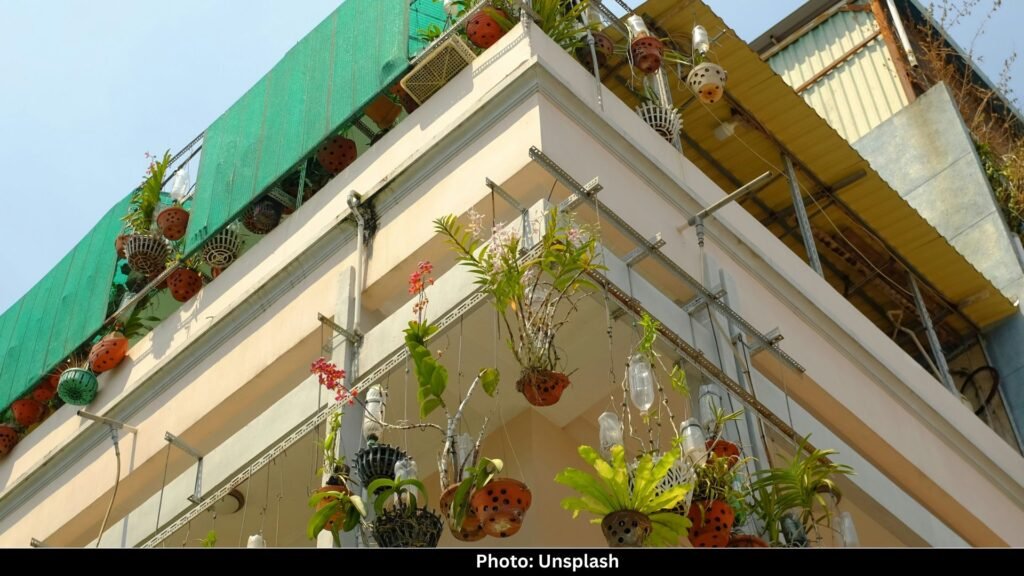Step out onto a balcony in the morning and notice what happens. Coffee in one hand, watering can in the other, you glance at your pots. Maybe a basil that refuses to behave, a money plant stretching toward the railing, or a stubborn succulent clinging to life. You lean closer, touch the soil, adjust a leaf and words just come out.
Not a speech. Not a performance. Just small things: you look good today, or what’s wrong with you this week? Maybe even a sigh about your boss, your partner, or the weather. Nobody taught us to do this, yet so many of us do. It feels natural, almost necessary.
Why? Because plants, especially the ones closest to us like balcony companions, occupy a strange space between object and presence. They do not talk back, but they are alive. And that life pulls something out of us.
The Deep Psychology Behind It
Humans need connection. We need it so badly that when we cannot find it in people, we pour it into pets, landscapes, and yes, plants. Psychologists call it biophilia, the instinct to connect with living systems. A balcony in a crowded city becomes a substitute for a field, a forest, or a meadow. Those pots are your patch of life in a landscape of steel and concrete.
Talking to plants is part instinct, part therapy. They will not argue, interrupt, or judge. They are steady, loyal, and nonreactive. You can whisper your secrets to a hibiscus, complain to a snake plant, or dream out loud to a row of tulsi. The act itself eases your nervous system. Your voice slows. Your breath deepens. Stress levels fall. So while it looks like you are doing it for the plant, you are doing it for your own nervous system as much as theirs.
A Long Tradition of Plant Whispering
This is not a modern quirk. People have been treating plants as companions for centuries. In India, tulsi is spoken to like family. In Japan, tending bonsai often involves quiet conversation, not just pruning. Ancient farmers sang to crops in the belief that the fields would yield more.
In the 19th century, German psychologist Gustav Fechner suggested plants respond to human attention. His theory sounded eccentric at the time but sparked a wave of experiments. In the 1970s, The Secret Life of Plants popularized the idea that plants feel emotions, sense human moods, and respond to sound. Much of it was exaggerated, but the cultural seed was planted: maybe plants are not as silent as they seem.
What Science Actually Says
Let’s clear this up. Plants do not have ears. They do not decode language. But they do sense vibration. When you speak, your voice is not just sound, it is waves of moving air. Leaves and stems pick up those vibrations. Cells register them as subtle mechanical signals.
Research has shown that sound waves can influence germination, growth, and flowering. Some studies found plants exposed to gentle music grew taller and produced more leaves. Others showed that harsh, chaotic noise had the opposite effect. So your balcony fern is not following your words, but it is registering the rhythm and tone of your voice in ways that affect its biology.
Your Breath Feeds Them Too
There is also a simple, overlooked factor: carbon dioxide. Every time you lean in and talk, you exhale CO₂. Plants need it for photosynthesis. You literally feed them as you speak. That may not sound romantic, but it is part of why your plants thrive in your presence. Add regular watering, pruning, and attention, and they are bound to look healthier than neglected ones.
Plants as Witnesses to Daily Life
Think about it. These balcony companions stand there through everything. They see you sip morning tea, slump after long workdays, argue with family, laugh with friends, or sit in silence scrolling on your phone. They never leave the balcony. They absorb the seasons, the moods, the rhythms of your life.
When you talk to them, you give them a role in that life. They become confidants, not in a mystical sense, but in the way that something living and silent can hold your words without judgment. That is why their death feels heavier than we expect. When a plant you have spoken to for years wilts and fades, it feels like losing a quiet companion who shared your balcony through countless days.
Music, Sound, and Plant Preferences
Plenty of people go beyond talking and play music for their plants. Experiments suggest plants exposed to steady, harmonious sounds such as classical, acoustic, or even the hum of bees often show stronger growth. In contrast, loud, erratic noise can stunt them.
Think of vibration like diet. Some frequencies feed their systems, others stress them out. That is why your plant near the busy street may grow differently from the one tucked against your quiet window. Each is shaped by its sound environment, including your voice.
Plants Communicate Too
It is easy to think of them as passive, but science has revealed something fascinating: plants send signals of their own. Roots release chemicals that warn neighbors of drought or pests. Damaged leaves emit distress molecules that nearby plants pick up. Some even release ultrasonic clicks under stress, sounds we cannot hear without special devices.
So if plants are already in constant, invisible dialogue with each other, it does not feel far-fetched that your words become part of the soundscape they register. They are not just decorations. They are players in a larger, ongoing conversation of life.
Why Balcony Plants Matter More Than Garden Plants
Here is something subtle. Balcony plants are different from garden plants. They are closer to you, physically and emotionally. You pass them dozens of times a day. They are outside the kitchen, the bedroom, the living room. You notice when a new leaf unfurls. You see when one droops. That frequency of contact builds intimacy.
A backyard tree feels like part of the land. A balcony pot feels like part of the household. Which is why it is balcony plants that we so often speak to, almost as if they were housemates in clay containers.
The Skeptic’s Take
Of course, not everyone buys into this. Critics say talking to plants only helps the human, not the plant. And they are partly right. Your words do not matter. But the act of speaking makes you pay more attention. You notice soil moisture. You trim dead leaves. You water consistently. The plant thrives not because of conversation itself, but because you have built a routine around it.
Still, dismissing it as all in your head misses the point. If the plant grows better and you feel calmer, who cares if the mechanism is direct or indirect? The outcome is real.
Mental Health Gains for Humans
On your side, the benefits are undeniable. Gardening is known to reduce anxiety and depression, and even small rituals like watering or whispering to a plant can anchor your day. That balcony corner becomes a microcosm of control and care in a world that often feels chaotic.
When you talk to a plant, you slow down long enough to notice life outside yourself. That shift in perspective is healing. It is why hospital patients recover faster when plants are in their rooms. It is why stressed city dwellers cling to balcony gardens like lifelines.
Culture Shapes the Habit
How people frame this habit depends on culture. In Indian homes, tulsi is treated with reverence and spoken to like a sacred elder. In Japan, the act of caring for bonsai is tied to mindfulness and patience. In the West, people often name their plants and treat them like pets. Different traditions, same instinct: to acknowledge that this patch of green is alive and deserves attention.
What This All Adds Up To
So let us be clear. Your balcony plant is not parsing the meaning of your words. But it is registering your presence, your breath, your tone, your care. You are shaping its growth just by being there. And in return, it shapes your mood, your sense of space, and your daily rhythm.
The relationship is not one of equals. It does not need to be. It is a quiet partnership, one where your words carry weight, even if they land in leaves instead of ears.
Try This Tomorrow
If you want to test it, pick one plant. Greet it every morning. Notice its soil. Breathe near it. Speak gently. Do this for a few weeks. You will start to see the difference. The plant will likely look better. And you will feel different too, calmer, more grounded, less alone.
Read More: Why We Always Choose That One Corner of the Bed – The Psychology of Sleeping Spots




